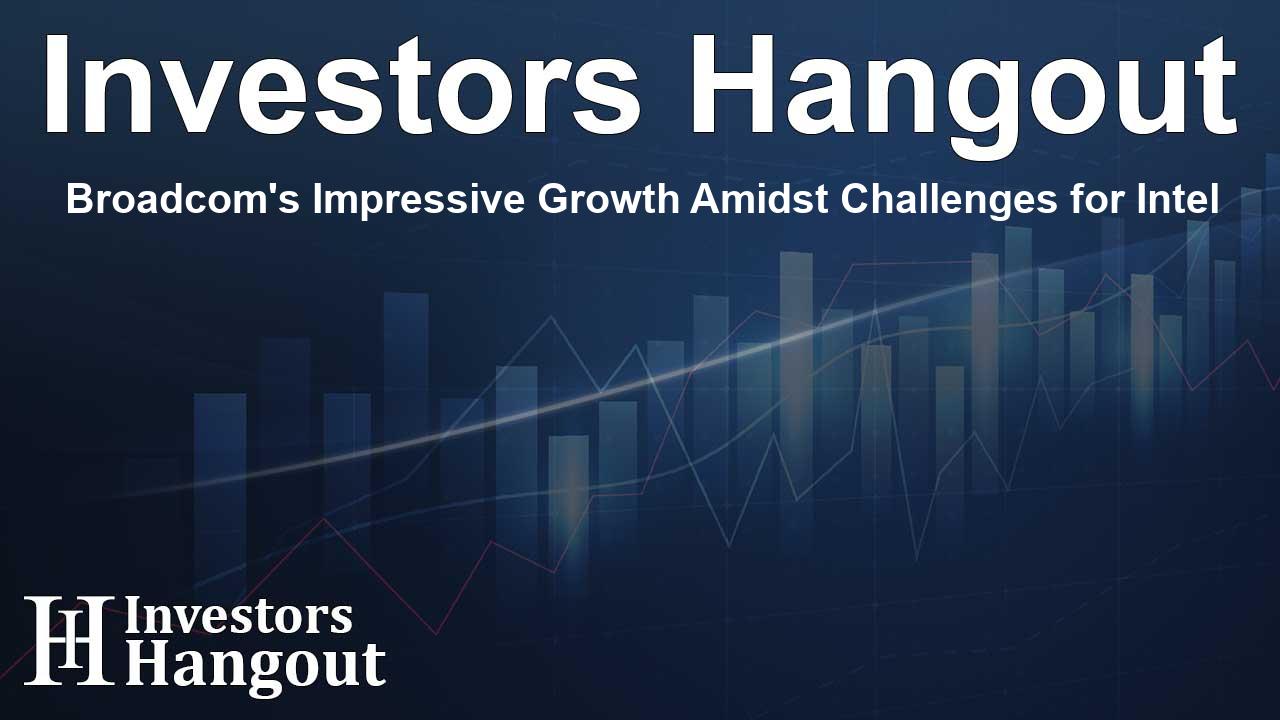Broadcom's Impressive Growth Amidst Challenges for Intel

Broadcom's Transformation in the Semiconductor Industry
The semiconductor industry in 2024 became a story of two major players: Broadcom Inc and Intel Corp. While Broadcom embraced the technological advancements driven by artificial intelligence, Intel found itself grappling with significant challenges in adapting to market shifts. This dynamic encapsulates the broader trends within the tech sector, reflecting how companies can either soar or stumble based on their strategic decisions.
Broadcom's AI-Driven Success
Broadcom’s stock has skyrocketed by 114% recently, showcasing an impressive reception from investors who recognize the company’s ability to capitalize on artificial intelligence growth. Unlike some competitors still struggling to find their footing, Broadcom has established itself firmly in the trillion-dollar club, alongside other tech giants like Nvidia and Taiwan Semiconductor Manufacturing Co. This status reflects their vital role in fulfilling the soaring demand for AI technologies.
Strategic Partnerships with Big Tech
One factor behind Broadcom's success is its partnerships with top tech companies, such as Alphabet, Meta Platforms, and Microsoft. By providing custom chips that meet the needs of these major players, Broadcom has solidified its position in the semiconductor landscape. The company's chief, Hock E. Tan, revealed ambitious plans to double XPU shipments specifically aimed at meeting the requirements of hyper-scale providers, catering to the growing needs of the AI sector.
Intel's Significant Decline
In stark contrast, Intel’s stock has seen a dramatic decline of 58%. Once a leader in microprocessors, Intel has faced fierce competition from companies like Qualcomm, Arm Holdings, and even Apple, all of which have outperformed in mobile chip markets. This shift has rendered some of Intel's traditional CPU products less relevant in environments increasingly dominated by AI-driven architectures.
The AI Challenge
Nvidia has emerged as a key player in this transformation, as their GPUs have evolved from gaming hardware to essential components for AI model development. The market's shift towards AI has not only reduced Intel's influence in traditional sectors but has also spurred its rivals to capture significant market share, leaving Intel in a precarious position.
Market Dynamics of AI and Chip Production
Broadcom is riding the AI wave with strong expectations that AI-related revenue will constitute a substantial portion of its overall earnings—projected to rise from 40% to 65% in just a quarter. With insights from respected analysts foreseeing continued demand, Broadcom is well-positioned for sustained growth in this sector.
Intel's Future Direction
Intel has announced plans to release its AI chip, Falcon Shores, which it hopes will reinvigorate its presence in the industry. Moreover, the company has indicated it will separate its foundry business, aiming to enhance operational focus. However, meaningful external sales are anticipated to remain elusive until at least 2027, underscoring the scale of their recovery challenge.
Investor Sentiment and Future Outlook
As the semiconductor landscape evolves, investors continue to seek opportunities in this high-stakes arena. The soaring stock price of Broadcom, coupled with its strategic positioning, illustrates the potential for significant returns in the tech sector. Meanwhile, potential investors considering entry into the semiconductor market are drawn to ETFs such as the VanEck Semiconductor ETF and the iShares Semiconductor ETF for diversified exposure.
Sector Performance Analysis
The performance of semiconductor stocks is a testament to technological advancements and shifting consumer preferences, particularly in AI technologies. While Broadcom has thrived by adapting to the demands of big tech, Intel's struggles highlight the importance of innovation and competitive strategy in this rapidly changing market.
Frequently Asked Questions
What factors contributed to Broadcom's stock surge?
Broadcom's stock surge can be attributed to its strategic partnerships with major tech firms and its ability to capitalize on the growing demand for AI-driven technologies.
How has Intel's business strategy changed recently?
Intel is shifting focus by developing new AI chips and restructuring its foundry business to enhance efficiency, but it faces challenges with market share and competition.
What role does AI play in the semiconductor market?
AI is significantly influencing demand for semiconductors, driving companies like Broadcom to increase production of specialized chips and innovate continuously.
What investments can one consider in the semiconductor sector?
Investors may explore ETFs like the VanEck Semiconductor ETF and iShares Semiconductor ETF for diversified exposure to the semiconductor industry.
What are the predictions for Broadcom in the coming years?
Broadcom is expected to maintain strong growth, primarily due to its increasing revenue from AI-related products and expanding market share among tech giants.
About Investors Hangout
Investors Hangout is a leading online stock forum for financial discussion and learning, offering a wide range of free tools and resources. It draws in traders of all levels, who exchange market knowledge, investigate trading tactics, and keep an eye on industry developments in real time. Featuring financial articles, stock message boards, quotes, charts, company profiles, and live news updates. Through cooperative learning and a wealth of informational resources, it helps users from novices creating their first portfolios to experts honing their techniques. Join Investors Hangout today: https://investorshangout.com/
Disclaimer: The content of this article is solely for general informational purposes only; it does not represent legal, financial, or investment advice. Investors Hangout does not offer financial advice; the author is not a licensed financial advisor. Consult a qualified advisor before making any financial or investment decisions based on this article. The author's interpretation of publicly available data shapes the opinions presented here; as a result, they should not be taken as advice to purchase, sell, or hold any securities mentioned or any other investments. The author does not guarantee the accuracy, completeness, or timeliness of any material, providing it "as is." Information and market conditions may change; past performance is not indicative of future outcomes. If any of the material offered here is inaccurate, please contact us for corrections.